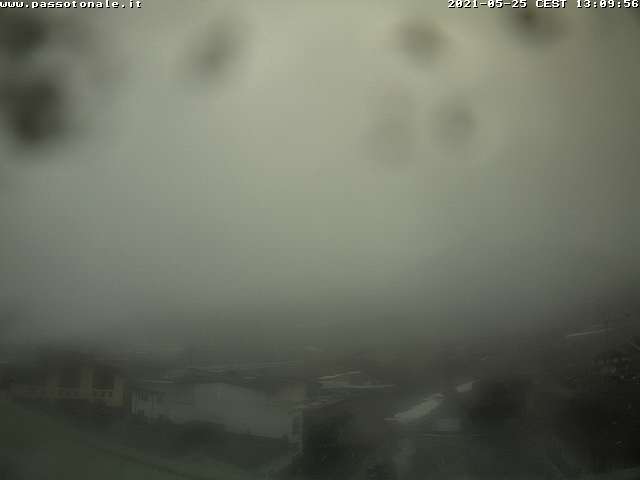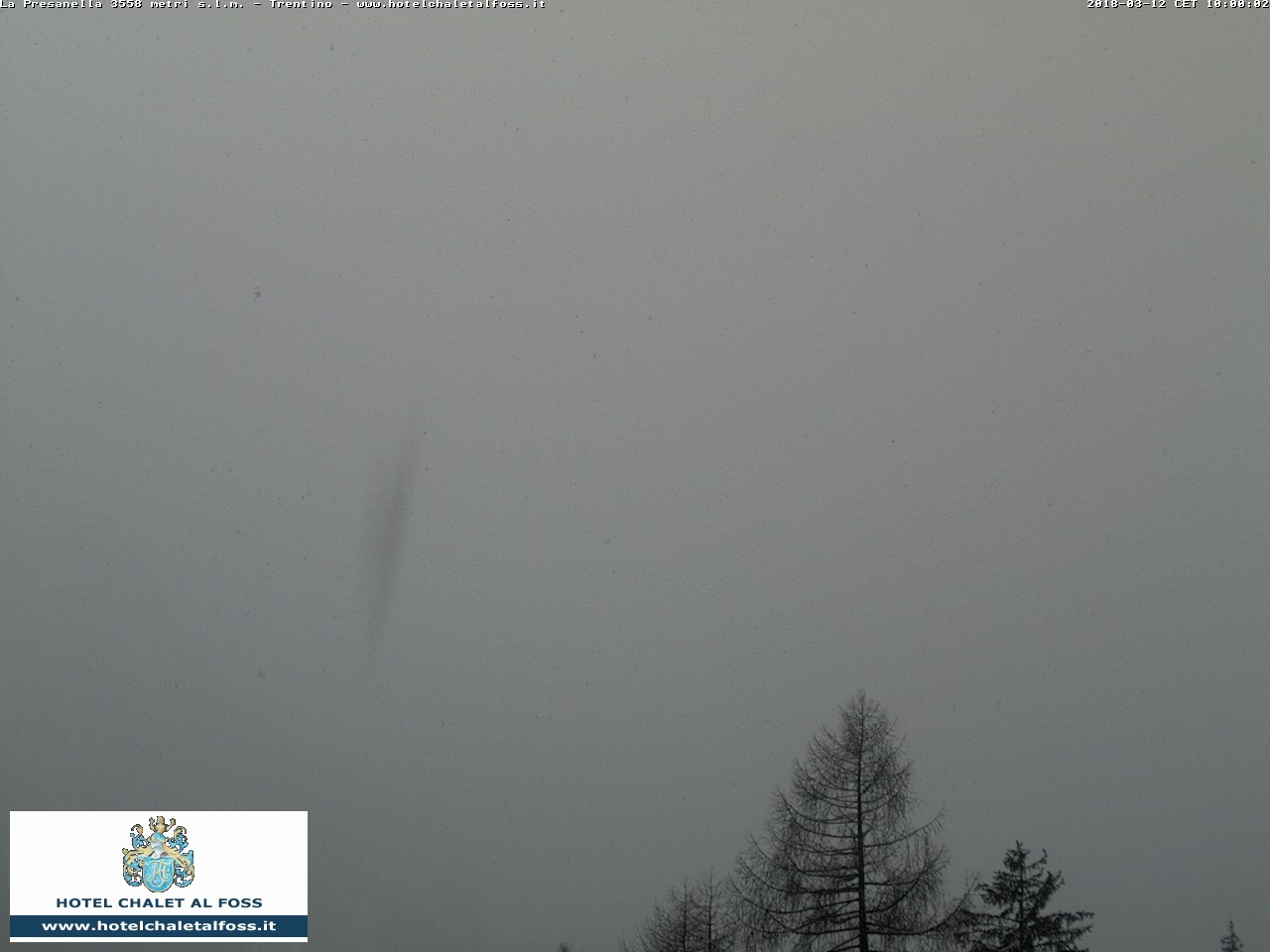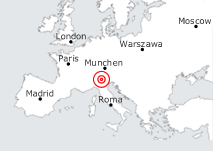Food and wine
| Its sheltered position amid the mountains has allowed the Val di Sole to preserve its gastronomic traditions virtually unchanged to this day, aware that they have been shaped, on the one hand, by centuries of contacts and dealings with the German-speaking world – numerous recipes from which the valley dwellers have adapted – and on the other, by the poverty of the local country folk, which led them to invent simple, nutritious dishes with the scant resources available. To this day, the Trentino area boasts a deliciously rich variety of produce, from apples and wild berries to the cheeses that are still produced in the traditional way in the dairy huts high up in the mountains. The trentini have always been skilled at making the most of everything the local livestock has to offer, from cheeses to top-quality cured meat products. The milk comes exclusively from naturally fed animals, and the cheeses are made using traditional production methods handed down through the generations. |
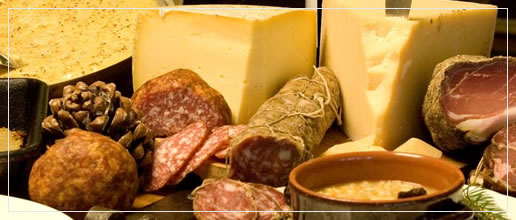 |
Strangolapreti
| Ingredients: 300 g of spinach, 2 stale bread rolls, milk as required, 2 eggs, 2 tbsps. of wheat flour, butter, a few sage leaves, grated grana cheese, salt. Strangolapreti, which is also sometimes made using nettle shoots, Swiss chard or wild spinach, is undoubtedly one of the most characteristic dishes of the Trentino area, and perhaps one of the best known outside of the region. The first thing to do is take care of the spinach: clean and wash it carefully, then steam it or boil it in a small amount of water. Drain the spinach, squeeze out the excess water and press it through a sieve. In the meantime, crumble up the bread and bathe it with a little milk, then add the eggs and flour, along with a little salt and mix it all together. Add the spinach into mix and then prepare small gnocchi about the size of a walnut. Fill a fairly large pan with salt water, bring to the boil and cook the gnocchi - a few at a time so as to avoid them sticking together – until they float to the top. Drain them carefully and serve with grated grana cheese and melted butter flavoured with a few fragrant sage leaves. Recommended wines: White, preferably Pinot, served at a temperature of 8-10 °C. |
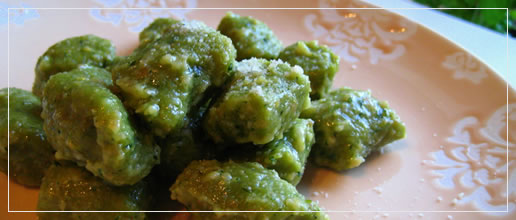 |
Canederli
| Ingredients: 300 g of stale bread, 150 g of speck or semi-cured lucanica sausage, half an onion, 2 eggs, two cups of wheat flour, 2 tbsps. of chopped parsley, a bunch of chives, a knob of butter, 1 ¼ litres of meat stock, salt. Canederli are traditional country fare, and make a substantial meal, several variants of which can be found. Cut the bread up into cubes and place it in a bowl, then cut the speck or lucanica up into tiny cubes and add it to the bread. Wash the onion, chop it up finely and fry it in the butter. Beat or whisk the eggs with some of the milk, add the parsley and pour the whole mix over the bread. Leave to rest for about half an hour before adding the flour, salt, lightly fried onion, and if necessary, a little more milk. Dip your hands in water and shape the mix into balls, then place the canederli in boiling salted water. Boil over a moderate heat for just over a quarter of an hour, and serve in meat stock sprinkled with chives. Sometimes, especially if this is your first attempt at canerderli, it is worth cooking just one first, so as to make sure the ball does not come apart in the water; if this is the case, add a little flour to the mix. The canederli can also be cooked directly in the meat stock. Recommended wines: Undoubtedly Schiava, one of the historic wines of the Trentino area, obtained from the red grapes most widely grown in the region, served at a temperature of 16-18 °C. |
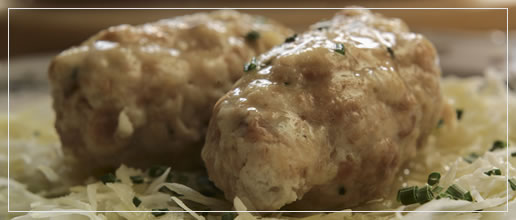 |
Polenta di formenton
| Ingredients: 300 g of buckwheat flour, 2 litres of milk, half a litre of dry white wine, butter, salt. 300 g of maize flour per litre of water for a thick, compact polenta, 250 g for a medium-thick polenta, 200 g for a very soft polenta, salt. For best results, polenta should be cooked in a copper pot over a wood-burning fire. To cook it properly, polenta should be mixed clockwise virtually all the time, using the traditional wooden méscola (a long utensil similar to a rolling pin), which should be drawn diagonally across the mix from time to time. What is especially important is to avoid unpleasant lumps forming; this can be done by sprinkling the flour into the water just before it boils and mixing it in to begin with using a standard kitchen whisk. The polenta should be cooked for at least 40 minutes, and can be left to cool for a few minutes once it has been tipped out onto the wooden board it is served on. Recommended wines: Red, preferably Cabernet or Lagrein, served at a temperature of around 18 °C |
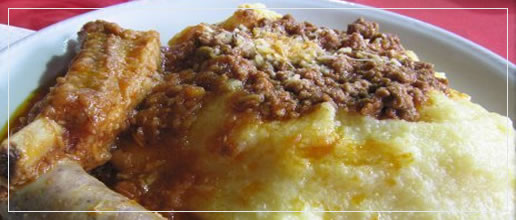 |
Roe and fallow deer venison stew
| Ingredients: 1.5 kg of roe or fallow deer venison, 2 carrots, 2 stalks of celery, 1 onion, 2 laurel leaves, 1 sprig of rosemary, 2 cloves, a pinch of cinnamon, 1 glass of red wine, 3-4 ladlefuls of vegetable stock, 2 tsps. of wheat flour, extra-virgin olive oil, salt, pepper. Clean and wash the onion, carrots and celery. Finely chop the vegetables and brown them in a pan with a little oil. Add the meat, cut up into pieces as for any kind of stew, brown it in the oil and add a little salt and pepper. Add the wine, and just before it evaporates completely, add 3 or 4 ladlefuls of vegetable stock. Leave to simmer slowly, adding the laurel leaves, rosemary, cinnamon and a couple of cloves. Slow-cook for 3 hours, make sure the meat is always covered by the liquid and that it does not stick to the bottom of the pan. Half an hour before the meat is ready, add the flour dissolved in the water, so as to thicken the sauce, and add a little salt if necessary. The stew is best enjoyed with a nice thick buckwheat polenta. Recommended wines: Red, preferably Teroldego Rotaliano or Cabernet, served at a temperature of 18-20 °C. Remember to uncork the Cabernet an hour before serving. |
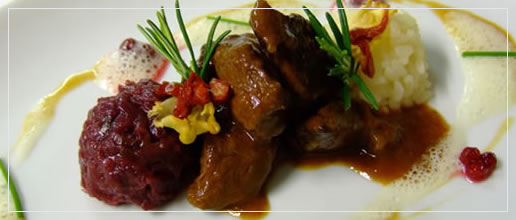 |
Dried salted cod with potatoes
| Ingredients: 800 g of soaked cod, 3 good-sized non-floury potatoes, a quarter of a medium-sized celeriac root, 1 onion, 2 cloves of garlic, 2 tbsps of tomato sauce, 1 tbsp of wheat flour, half a glass of dry white wine, a bunch of parsley, extra-virgin olive oil, 50 g of butter, salt, pepper. Until just a few decades ago, cod was a highly affordable variety of fish, which may partly explain how widely used it was in traditional Trentino cooking. The monks from the convent of Terzolas were particularly renowned for their skill in cooking the fish to perfection. This is one simple recipe: leave the cod to soak overnight in cold water, and the next day, boil it until the flesh comes away easily from the bones. Drain the fish, remove the scales and break it up into pieces with your hands. Pour a little oil into a pan, add the pieces of cod, cover with a layer of celeriac, cleaned and sliced thinly, a layer of onion rings and a layer of thinly sliced potatoes. Salt gradually, add a pinch of pepper and the cloves of garlic. Add a little oil and sprinkle with little curls of butter, then cook over a moderate heat for about twenty minutes, without mixing. Transfer the pan into a barely warm oven and cover with a sheet of aluminium cooking foil. Gradually turn the heat up to 200 °C and cook for about an hour. Halfway through, remove the cod from the oven and pour over it a mixture prepared separately by diluting the flour with the tomato sauce and white wine. Finally, remove from the oven and sprinkle with chopped parsley. Serve with polenta. Recommended wines: White, preferably a brut sparkling wine such as Trentino Chardonnay, served at a temperature of 6-7 °C. |
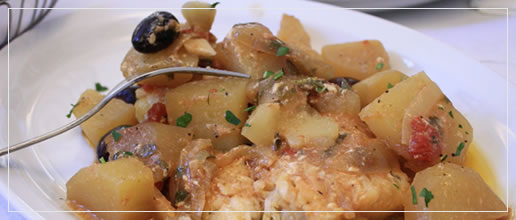 |
Patate rostide
| Ingredients: boiled potatoes, a slice of yellow polenta, lard or bacon, salt. Patate rostide is a typical dish from an almost forgotten age. It used to be eaten mostly in the evening, along with cheese and finely chopped chicory, but it was not uncommon to find it on the breakfast table, perhaps accompanied by some barley coffee. It was a way of using up leftover polenta and potatoes, or more often than not, an inventive new way to dish up potatoes. Cut the lard or bacon up into pieces and place it in a pan, preferably made of iron. Melt the pieces and brown them well over a moderate heat. In the meantime, peel the potatoes boiled the day before, slice them fairly thinly and roughly cut up the slice of polenta. Add the ingredients to the pan and turn the mixture over and over again over a lively heat for about 15 minutes, using a wooden spoon, until the potatoes become golden and tasty. Serve with raw seasonal vegetables. |
 |
Sauerkraut
| Ingredients: 1 kg of sauerkraut, 1 good-sized onion, 1 clove of garlic, 1 laurel leaf, 4 peppercorns, 3 juniper berries, 1 tbsp. of wheat flour, butter, salt, pepper. Sauerkraut, as well as being eaten raw in order to preserve its superb natural properties, can also be cooked in a wide range of ways. Here is just one of them: Place the sauerkraut in a pan, add just enough water to cover it, then add half a sliced onion, the laurel leaf, the garlic, the peppercorns and the juniper berries and cook for about half an hour over a moderate heat. In the meantime, in another pan, brown the rest of the onion, chopped, in the butter, sprinkle over the flour and brown the whole mixture, mixing carefully. Then add the sauerkraut and mix well. Add salt if required and flavour with a pinch of pepper to taste only once the sauerkraut is fully cooked. |
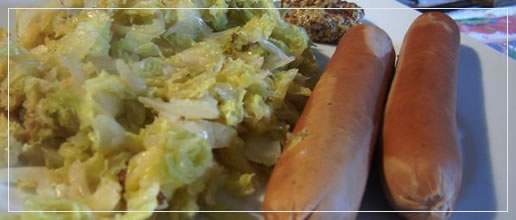 |
Apple Strudel
| Ingredients: For the pastry: 250 g of semi-wholewheat flour, 1 egg, 3 tbsps of extra-virgin olive oil, half a cup of water, a pinch of salt. For the filling: 2 kg of Renetta apples, 150 g of dry biscuits, 50g of sultanas, 50 g of pine nuts, 1 tbsp. of honey, the grated rind of 1 lemon, cinnamon, half a cup of apple juice. Mix a pinch of salt into the flour and make a fountain with the flour on a pastry board. Mix in the egg and 2 tbsps. of oil, then gradually add just enough water to give the dough the right consistency. Knead it for at least ten minutes, until it becomes smooth and elastic. Roll it into a ball, grease with a little oil and leave to rest for about half an hour. In the meantime wash and soak the sultanas, peel and slice the apples. Then place the two ingredients in a bowl, add the honey, the cinnamon, the pine nuts and the grated lemon rind, mix well and leave to macerate. Roll the dough out on a flour-covered tea cloth, aiming for a very thin pastry. Sprinkle the crushed biscuits over 2/3 of the pastry, then pour over the mixture from the bowl. Start rolling the pastry up by lifting the tea cloth from the side with the filling, so that the part of the pastry without the fruit is folded over the top. Using the tea cloth to help you, place the strudel on the oven plate or on a greased, floured oven dish and bake at 220 °C. After about half an hour, brush the pastry with the apple juice, then continue baking for about another 15-20 minutes. Recommended wines: Moscato Giallo, served at a temperature of 12 °C. |
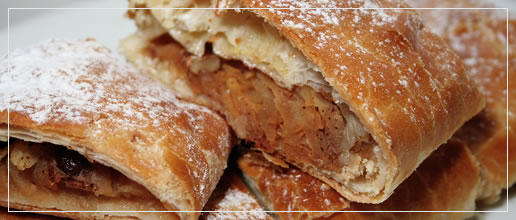 |
Zelten
| Ingredients: 400g of wheat flour, 400g of walnuts, 300g of dried figs, 150g of sultanas, 100g of candied citron, 200g of sugar, 120g of butter, 2 eggs, 2 small glasses of grappa, the grated rind of 1 orange, 1 sachet of yeast, a little milk, a pinch of salt. Zèlten is a traditional cake baked at Christmas, somewhat laborious to prepare, which keeps for several days in a cool place. Place the butter in a bowl and beat vigorously with the sugar and the eggs, then add the flour, yeast and salt. Add the milk and mix to a smooth paste with a wooden spoon. Add half of the walnuts, broken up into pieces, together with the roughly chopped figs, the whole pine nuts, the washed sultanas, the grated orange rind and the grappa. Work all the ingredients together for about 15 minutes and then place in a greased, floured dish: spread the mix out with your hands to a thickness of about 1 cm circa. Decorate with the remaining walnuts, halved, and bake in a hot oven for 40 minutes. Remove from the oven when the surface of the Zèlten has turned a nice reddish-brown colour. Recommended wines: Vin Santo dessert wine, with a pleasant, aromatic fragrance, served at a temperature of 8 °C. |
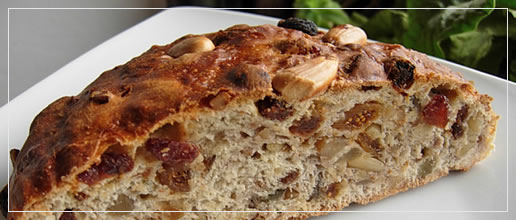 |
Apple cake
| Ingredients: 1 kg of Golden Delicious apples, 200 g of semi-wholewheat flour, 150 g of butter, 120 g of sugar, 1 lemon, 50 g of sultanas, 50 g of peeled almonds, 1 egg yolk, cinnamon, a generous pinch of salt. Make a fountain with the flour on a pastry board, then mix in 100g of butter heated over a pan of water, plus the egg yolk and the salt. Work the ingredients together until the mixture takes on a creamy consistency, then leave it to rest in the fridge for about an hour. In the meantime, peel the apples, slice them – not too thinly - and spray them with lemon juice. Once the mixture has rested, spread it out on a floured pastry board then transfer it to a cake tin, drawing the mix up the edges. Sprinkle with half of the washed sultanas, arrange the apple slices carefully on top, brush with 50 g of melted butter, then add the rest of the sultanas, the chopped almonds and the sugar, together with a pinch of cinnamon. Placed in a pre-heated oven and bake at 200 °C for about 45 minutes. Recommended wines: Moscato Giallo, served at a temperature of 10-12 °C. |
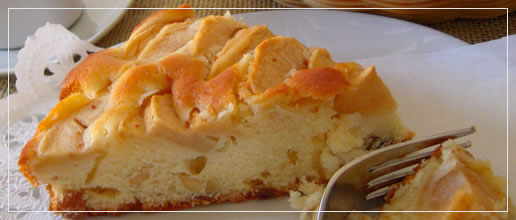 |
Torta de frigoloti
| Ingredients: 300 g of wheat flour, 150 g of butter, 100 g of sugar, a small glass of grappa, a generous pinch of baking soda, 1 egg yolk, 1 tsp. of honey, 700 g of peeled almonds, a generous pinch of salt. This is a fairly substantial, typical mountain sweet, with a distinctively buttery taste, which keeps well. Beat the butter with the sugar, then mix in the egg yolk, the honey, the salt and the grappa. Add the sieved flour, the baking soda and the crushed almonds. Arrange the mixture in droplets on a tart baking tin, carefully buttered, and bake in a pre-heated oven at about 150 °C for 15 minutes. Cut it while still warm so it does not crumble. Recommended wines: Moscato Rosa, served at a temperature of 12 °C. |
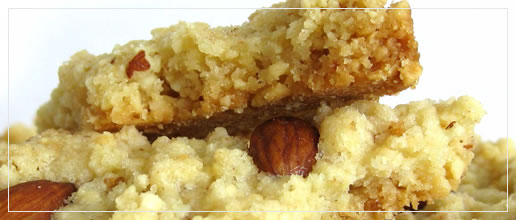 |




